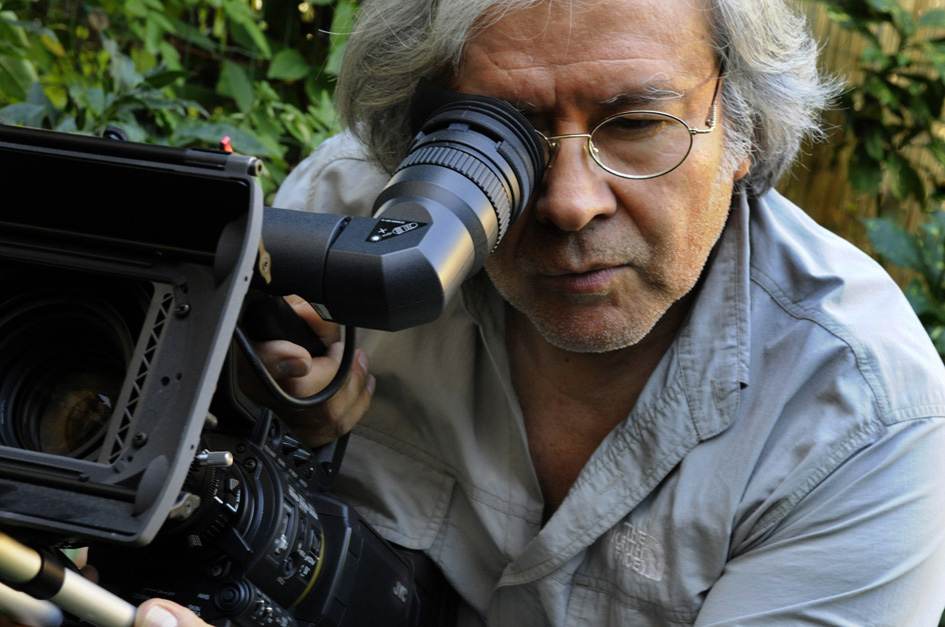BIOGRAPHY
Estay Patricio (NazcaVision)
Patricio Estay, French Chilian photographer, filmmaker & songwriter. After completing his degree in ethnomusicology, he embarked on a career in photojournalism. His first professional reportage was based on the military coup d’état in Santiago, Chile in 1973, an event which was to influence not only his career but his entire future. Later that year he was forced into political exile, seeking refuge in Brazil. During this period he completed several significant projects on a series of social issues, with a special focus on the people living in the Favelas and on street children.
Since the beginning, the photographic image has always been Estay’s natural medium as an author. The insight of his reportage, the strength of its content, and the richness and variety of his views characterise the personal and profound vision which fuels his career as a photojournalist.
In 1981, he moved to France where he started a new life and a prolific career in photography and publication. His photographs appeared in such publications as Vanity Fair (Italie), Le Figaro Magazine, Libération, L'Express, Animan, Geo (Germany, France, Spain, Russia and Korea), as well as Stern and Newsweek. In 1982 he had his first exhibition in France, “l’Amerique Latine à Paris", at the Grand Palais in Paris. In 1989 Estay and his close friend Cuban photographer Alberto Korda were co-exhibitors at the opening of "Visa pour l’Image" in Perpignan, France, which inaugurated the First International Festival of Photojournalism. The title of their exhibition was “Trente Ans de Révolution Cubaine".
In 1990 Estay began a project which would continue for the next ten years, documenting the equestrian cultures of ten different countries. In 2001 Estay published a book based on the aforementioned equestrian reportage, entitled Peuples Cavaliers, published by Le Chêne. Part of this work was exhibited in 1993 at the Visa, International Festival of Photojournalism. In 1997, he won the European Fuji Press Award prize in the Magazine category for his reportage “The Lord of the Bush”, shot in Australia.
In the same year Estay, inspired by his experience as a political exiled and by his meeting with Henri Cartier Bresson, started Tibet Land Of Exile, one of the most important projects in his career. He had been working for nine years beside the Dalai Lama and in the Tibetan community, who is in exile in Dharamsala, India. Tibet Land Of Exile is the title of a hardcover book published in Italy in 2007 by Skira, and by Thames & Hudson for the international market; it is also the title of the travelling exhibition presented in the most important locations in Florence, Milan and Rome. In 2003 he founded the agency Nazca Pictures Communication, and started living between Paris and Florence.
In 2008 he founded NazcaVision, a new HD film production unit to expand the documentary sector.
Today more than ever, Estay believes in the unlimited expression of image, freedom, passion and life through the medium of creativity and instintc.
Since the beginning, the photographic image has always been Estay’s natural medium as an author. The insight of his reportage, the strength of its content, and the richness and variety of his views characterise the personal and profound vision which fuels his career as a photojournalist.
In 1981, he moved to France where he started a new life and a prolific career in photography and publication. His photographs appeared in such publications as Vanity Fair (Italie), Le Figaro Magazine, Libération, L'Express, Animan, Geo (Germany, France, Spain, Russia and Korea), as well as Stern and Newsweek. In 1982 he had his first exhibition in France, “l’Amerique Latine à Paris", at the Grand Palais in Paris. In 1989 Estay and his close friend Cuban photographer Alberto Korda were co-exhibitors at the opening of "Visa pour l’Image" in Perpignan, France, which inaugurated the First International Festival of Photojournalism. The title of their exhibition was “Trente Ans de Révolution Cubaine".
In 1990 Estay began a project which would continue for the next ten years, documenting the equestrian cultures of ten different countries. In 2001 Estay published a book based on the aforementioned equestrian reportage, entitled Peuples Cavaliers, published by Le Chêne. Part of this work was exhibited in 1993 at the Visa, International Festival of Photojournalism. In 1997, he won the European Fuji Press Award prize in the Magazine category for his reportage “The Lord of the Bush”, shot in Australia.
In the same year Estay, inspired by his experience as a political exiled and by his meeting with Henri Cartier Bresson, started Tibet Land Of Exile, one of the most important projects in his career. He had been working for nine years beside the Dalai Lama and in the Tibetan community, who is in exile in Dharamsala, India. Tibet Land Of Exile is the title of a hardcover book published in Italy in 2007 by Skira, and by Thames & Hudson for the international market; it is also the title of the travelling exhibition presented in the most important locations in Florence, Milan and Rome. In 2003 he founded the agency Nazca Pictures Communication, and started living between Paris and Florence.
In 2008 he founded NazcaVision, a new HD film production unit to expand the documentary sector.
Today more than ever, Estay believes in the unlimited expression of image, freedom, passion and life through the medium of creativity and instintc.

